Norway have been responsible for producing some outstanding talent over the years in men’s football, with the likes of current Arsenal captain Martin Ødegaard, former Manchester United striker and manager Ole Gunnar Solskjær and Chelsea legend Tore André Flo all hailing from within its shores.
However, despite that, success on the international stage at the higher age ranges has been relatively moderate, with the senior team only appearing at one Euros and not qualifying for a World Cup since 1998, whilst their U21 side have appeared at two Euro U21 tournaments, but none since 2013.
However, this year sees the latter finally end their nine-year wait for another major tournament appearance, with them qualifying for this year’s Euros, which will be jointly hosted by Georgia and Romania, and they will no doubt be hoping to finally break through the semi-final hurdle that they fell at in both of their previous finals tournaments.
It will be far from a walk in the park if they are to do so though, with Leif Gunnar Smerud’s side drawn in the same group as Switzerland, France and Italy, all of whom have been in at least one final at this level.
This Norway U21 tactical analysis will look at the Norway team in greater detail, breaking down who is likely to be in their squad, their tactics in attack, defence and in transition and will pick out a key player for fans to look out for.
The Norway scout report will also provide an indication of what expectations there should be for them and a prediction of how far they can realistically progress.
Norway U21 Predicted Starting XI
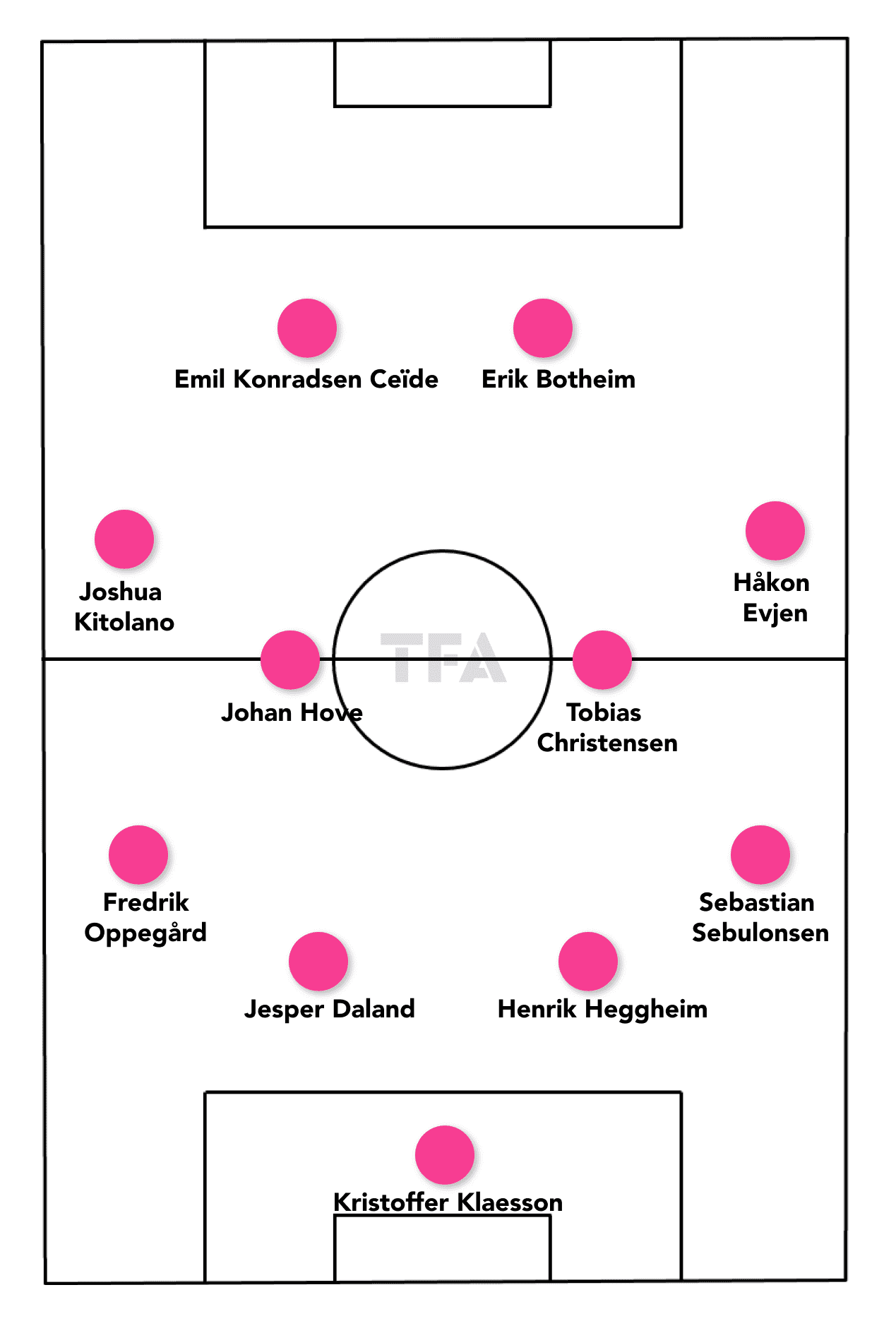
Norway have tended to fluctuate between formations over the last few years, but the structure that they currently favour is a 4-4-2, as it gives them balance around the field and provides them with an extra player at the top of it, which allows them to execute their game plan with more success.
In goal, Leeds United stopper Kristoffer Klaesson will likely be given the nod, with him having been the first-choice goalkeeper for Norway at U21 level for a decent period of time now, and he has demonstrated during his international career so far that he can be a reliable and safe pair of hands.
In front of him, the defensive line is likely to include Sebastian Sebulonsen at right-back, with the Brøndby player having made that role his own during the last years, as well as Cercle Brugge’s Jesper Daland and Vålerenga’s on-loan Brøndby player Henrik Heggheim at centre-back.
Where there may be some rotation is at left-back, with both Fredrik Oppegård of PSV, who is currently on loan at Go Ahead Eagles, and Leeds’ Leo Fuhr Hjelde, who has also been on loan this season, though with Rotherham United, solid options to pick from.
However, due to his ability to support attacks in the way that Norway demand when they have the ball, Oppegård may well edge Hjelde to be included.
In the wide areas, Norway like to have different types of wingers on the field, allowing them to both maintain the link with the defensive line and push forward to support attacks.
As a result, the combination of another Brøndby player, Håkon Evjen, and Sparta Rotterdam’s Joshua Kitolano looks to be a solid pairing, with the former being a creative player that many have highlighted as a star of the future, whilst the other doesn’t offer the same attacking threat and has other roles in the field during build-up play.
Between them, there also needs to be the right balance in order to make Norway’s tactics successful, and so including Groningen’s Johan Hove in his favoured deep-lying distributor will require a player alongside him who can put on energetic displays and who can move from box to box, and Tobias Christensen of Hungarian side Fehérvár would be a good fit for that role.
In the forward line, the two most obvious names to select are Emil Konradsen Ceïde and Erik Botheim, who play for Sassuolo and Salernitana respectively, with the latter being the team’s captain and a leader in every definition of that word, due to his ability to drop back into deeper areas in order to do what is needed for his team to progress the ball forwards, whilst Ceïde can generally be relied upon to score goals and pose a direct threat to opposing sides in a target player role.
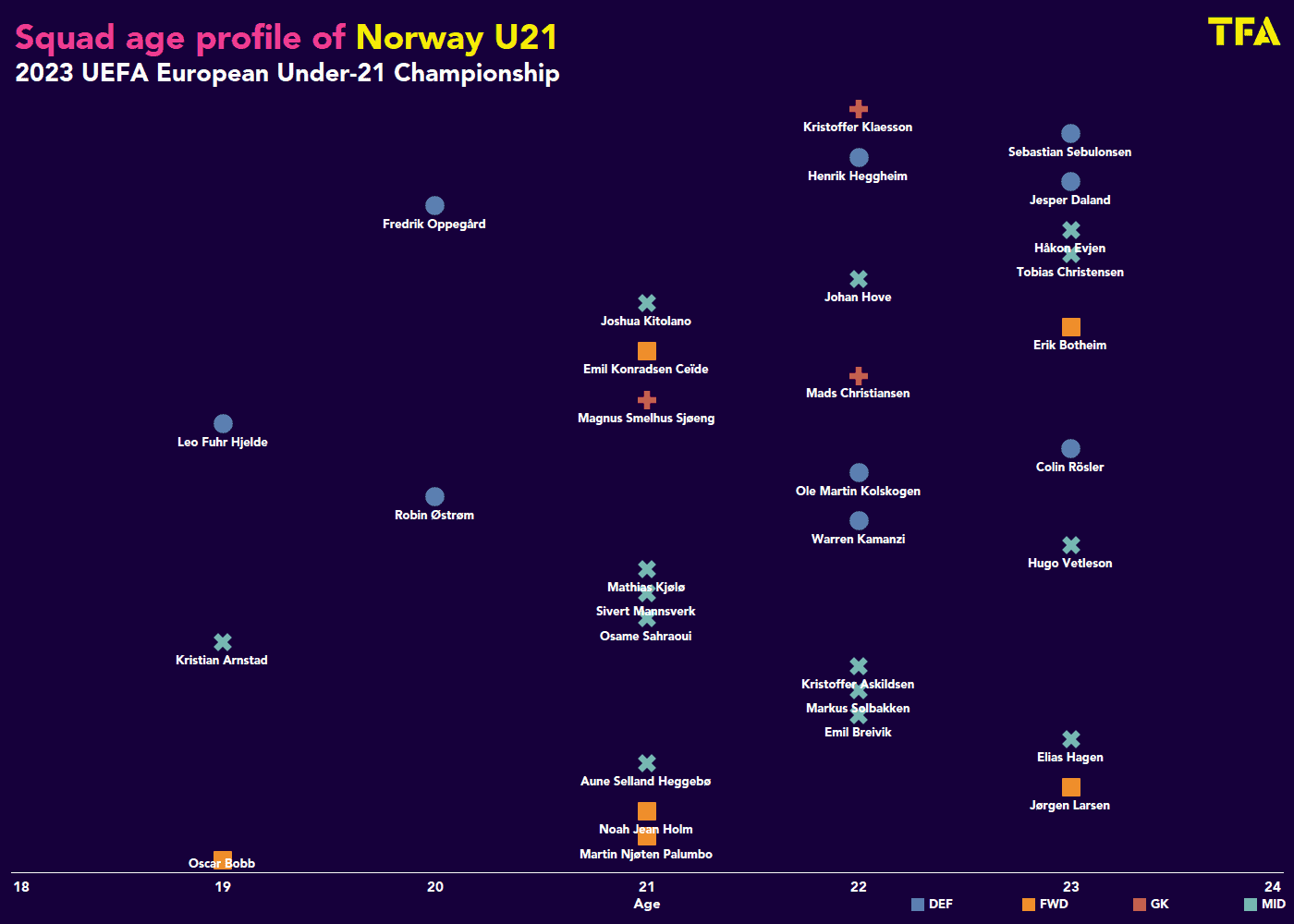
It is quite interesting to look at the spread of ages in Norway’s squad, with it clear from doing so that there is a preference for players at the experienced end of the scale, and many of those who are likely to be included in the Euro U21 squad are currently aged between 21 and 23.
This is perhaps due to Smerud having his core group which he has moulded during the qualifying stages that he feels deserve the chance to shine on the field, but it could also reflect how he knows that adding younger players now could be a risk, due to the team’s overall rhythm being potentially disrupted and those players not having enough time between now and the beginning of the tournament to adjust to his methods.
Norway Attacking Phase
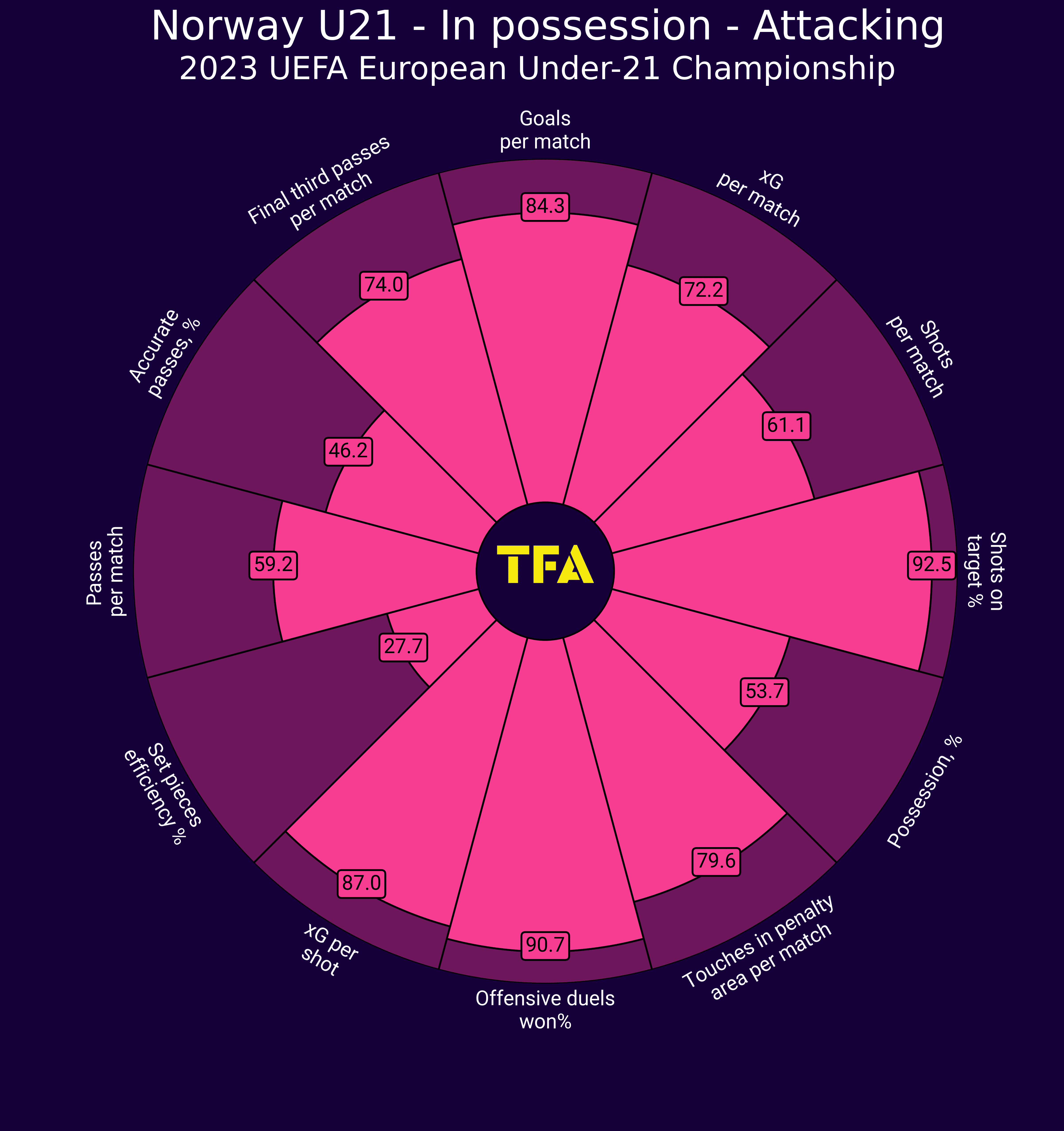
Turning attention to some of the key strengths and weaknesses in Norway’s attacking play, it is immediately clear to see from this graphic that their focus is on playing on the front foot and keeping the ball as high up the field as possible, with them ranking highly in percentile terms (compared to the other sides in the Euro 2021 qualifying rounds) for goals per match, final third passes per match, percentage of shots on target, touches in the opposing penalty area and percentage of offensive duels won.
However, what is also important to note is that, whilst they do like to play the ball forwards, they don’t rank highly for passes made or for passing accuracy.
This might initially sound odd, but it is likely to be down to their tendency to make longer passes in order to make territorial gains more quickly, and that allows them to move the ball around with fewer passes whilst also increasing the risk of possession being conceded.
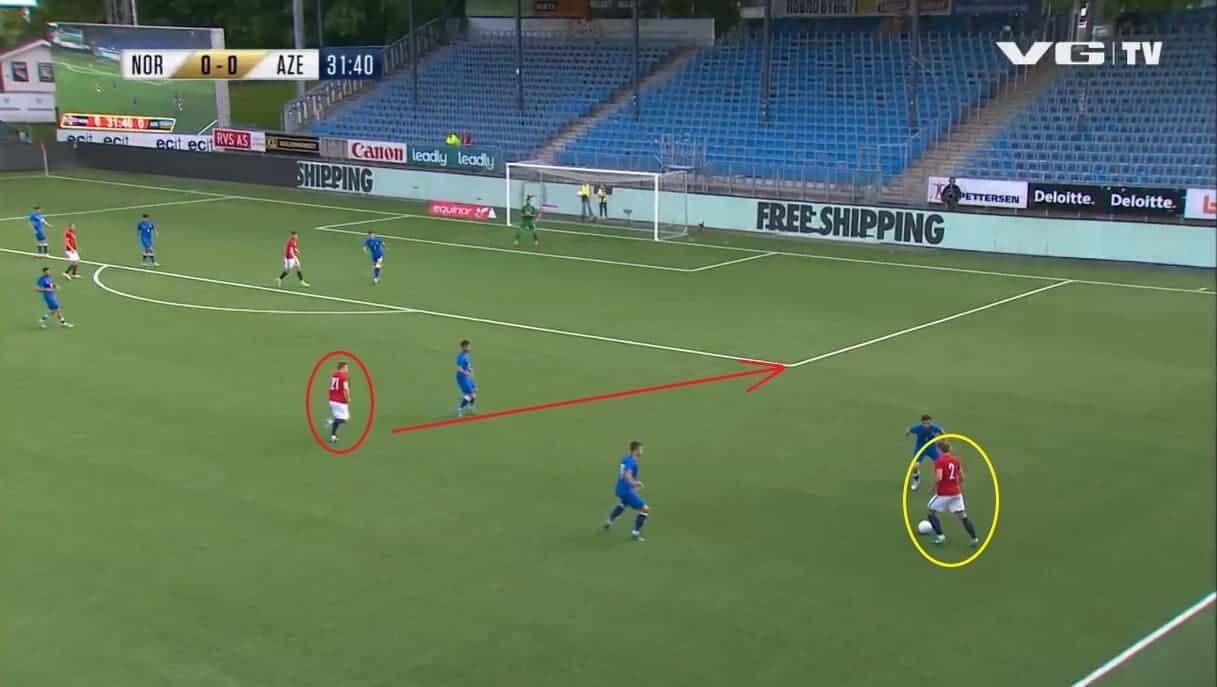
That last point is illustrated here, with Norway getting into the final third at speed and now having space available for them to move the ball into the goal area without needing to involve many players.
They have been helped out by Azerbaijan not reading the danger early enough and so leaving gaps open, but there is still a need for Norway to get the detail of their play right here in order to make the most of the opportunity.
In this case, with Sebulonsen on the wing and looking to make a pass, Christensen is the one who makes the run forward, with him getting beyond Adilkhan Qarahmadov and offering his teammate a way to pass the ball behind Qarabağ left-back Elvin Cafarguliyev, who had moved out to close Sebulonsen down and to allow Norway to progress the ball into the penalty area.
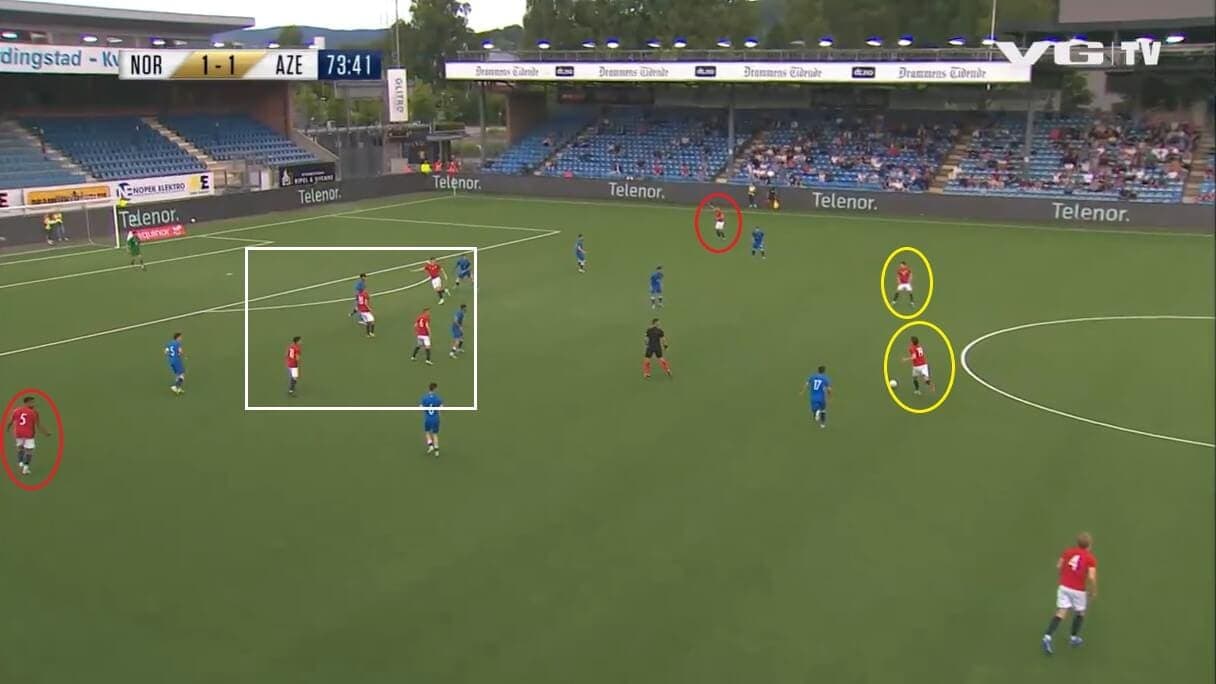
The fact that Norway’s right-back was so far forward in that situation is an important point to note because it links back to the point made about them getting on the front foot and pushing into advanced areas with the ball.
This is another situation when both Sebulonsen and Oppegård have once again pushed forward, and the overall picture indicates how this now forces Azerbaijan to stretch out and leave spaces open in their defensive line.
As a result, there are more gaps in the central areas for Norway to exploit, and Evjen, who started on the wing in this match, has moved infield to support his teammates in the middle channel, as was highlighted in the previous section of the analysis as something that he likes to do.
This then allows Norway to pick their moment to shoot at goal, with Evjen combining with Markus Solbakken before looking to test goalkeeper Akpar Valiyev.
On this occasion, his effort was tame and was easily picked up by the Azerbaijan stopper, but this was once again a situation that Norway created through the full-backs pushing forward and their right winger cutting inside to demonstrate his individual threat.
Norway Defensive Phase
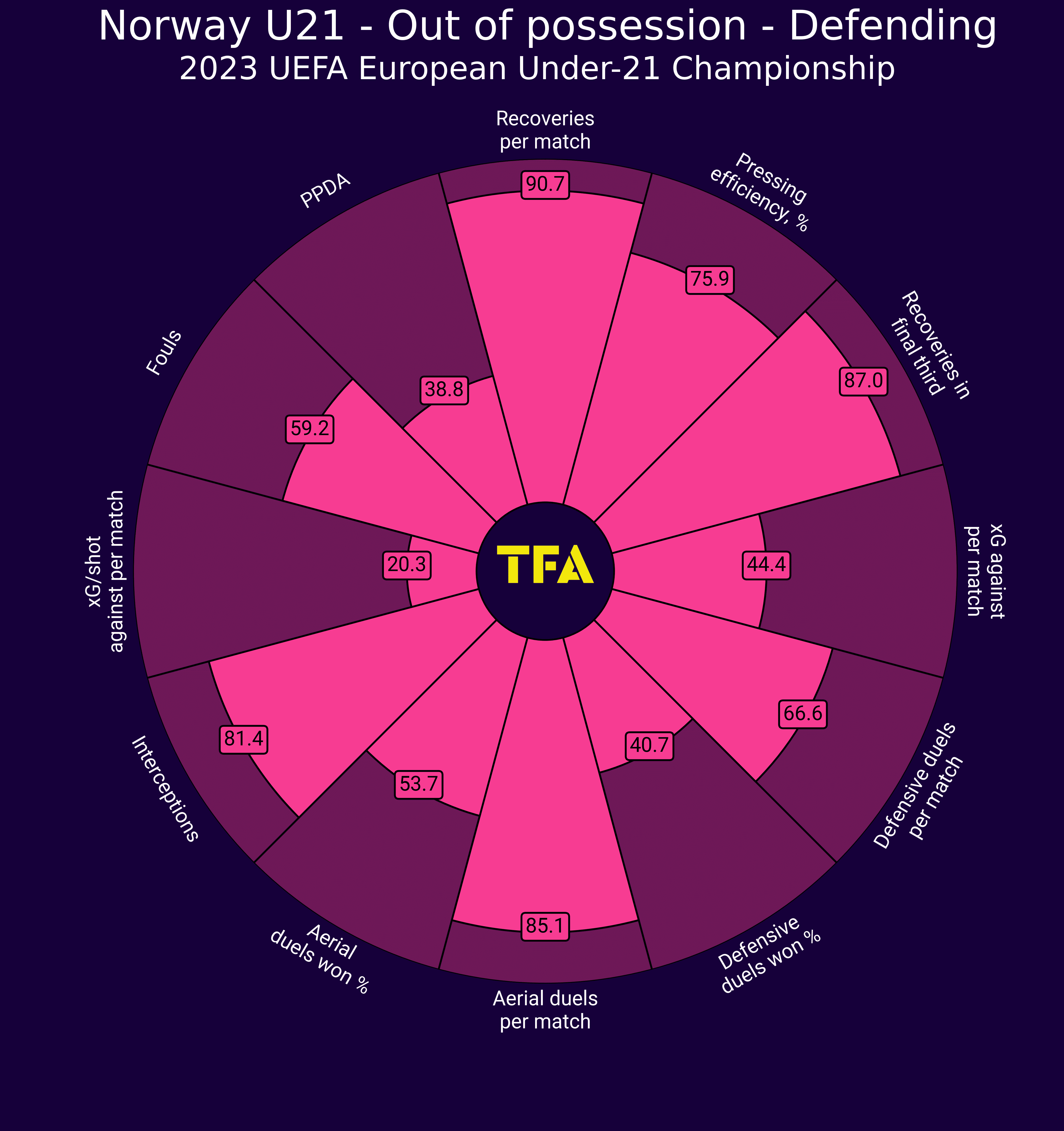
When defending, what immediately stands out about Norway is their ability to press with efficiency and to make key interceptions, with both of those aspects being things that they rank highly for in percentile terms in this graphic.
They do this at both ends of the pitch when without the ball, and it is a vital part of their game due to them being so open when they have it and therefore making it easy for opponents to launch counterattacks once they gain possession.
If Norway are to have a successful Euro tournament, then this will need to be at the forefront of their minds, as not being able to win the ball back or to break up opposing play could be the difference between them making it into the knockout stages and failing to get out of their group.
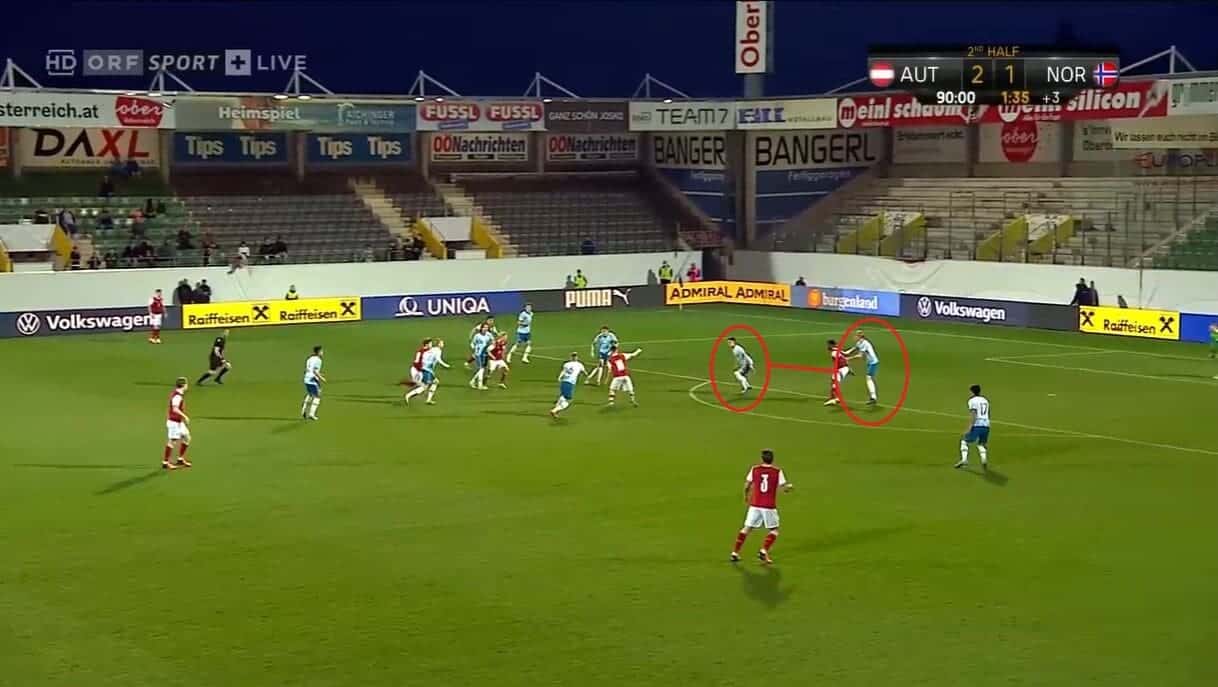
However, there is little doubt when watching them that they do have it in them to be defensively robust, with them continually working hard out of possession to prevent their opponents from having too many clearcut chances to test their goalkeeper’s resolve.
This comes down to them having the right combination of players at the heart of their defensive line, with that being the engine room of their efforts inside the final third, and what is really important to note is that Norway have different profiles of players that they can call on when they need to make changes.
Against Austria, for example, Smerud opted to introduce Colin Rösler to partner Daland during the latter stages in his attempts to prevent the home side from extending their lead, and both players worked hard to simultaneously press the Austrian players and protect their defensive line, with the result being that Austria rarely had time or space in possession in the closing minutes and were never able to consider the prospect of adding to their tally.
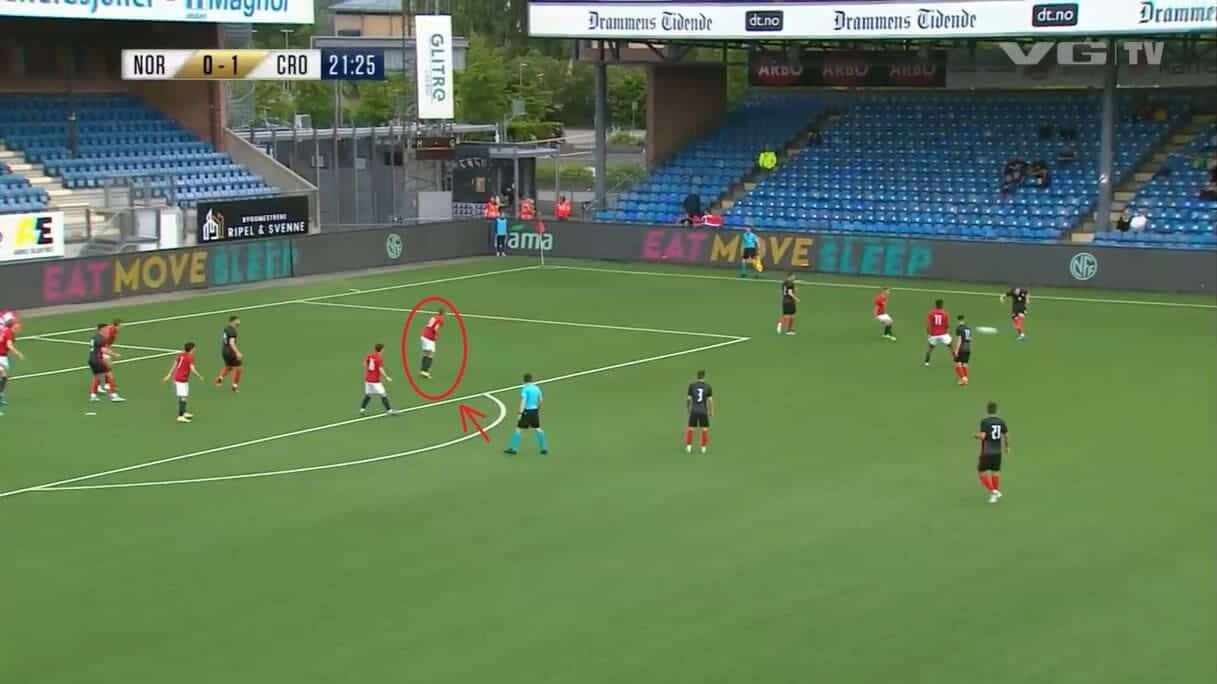
However, it is not only the central defenders who are expected to make the team hard to beat, with defending being a team effort, and that means that even the strikers track back to close gaps off when they see that there is a need for them to step in.
Here, Croatia’s Luka Sučić is looking to move the ball into the path of Roko Šimić, who is inside the goal area, and there was a strong possibility that finding the latter would have ended in a shot on goal.
However, Botheim read the danger and got back to make an interception, covering for the defenders who had gone out to try and prevent the cross from coming in, and that shows again how Botheim is a leader and is happy to help out where needed for his team, but also how Norway both attack and defend as a team.
Norway Transitions
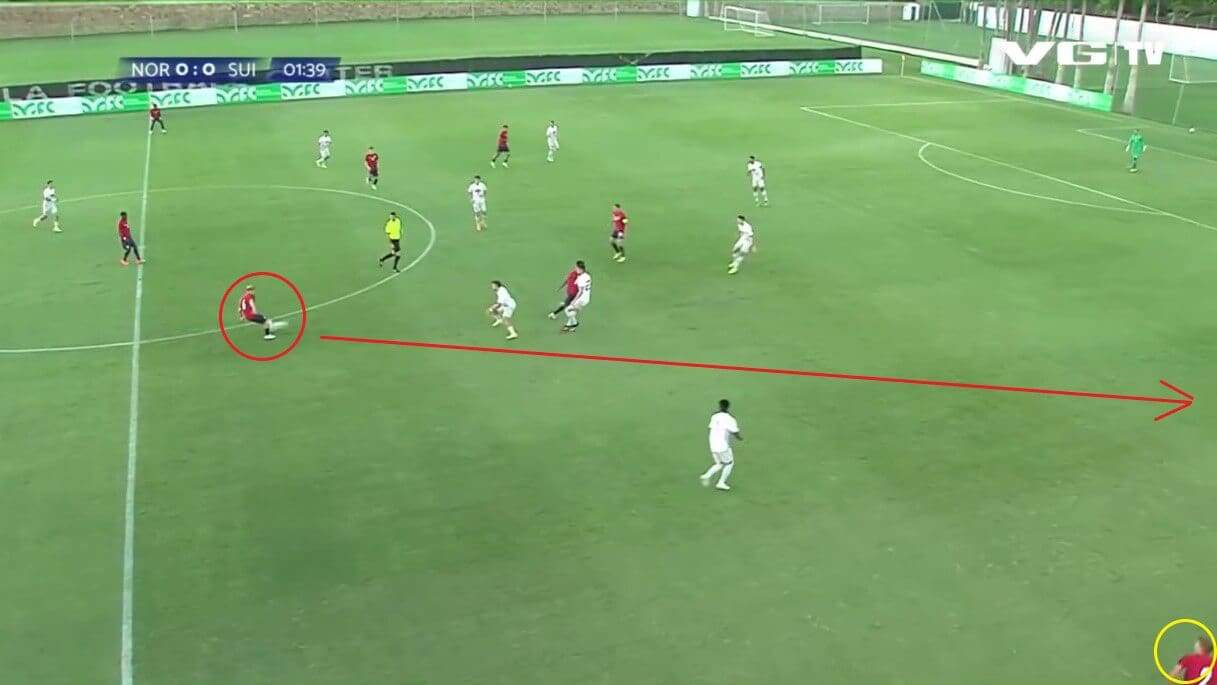
It has already been mentioned that Norway favour long passes as they look to move the ball up the field, but that doesn’t mean that they simply move it long as soon as they win it back from their opponents.
Instead, they play calm and measured football and wait for the right opportunity to present itself, as has been a theme throughout this scout report, ensuring that the risks of the ball being given away or the attack not leading to anything are kept as minimal as possible.
In this case, they have needed to move the ball around in the congested central channel against Switzerland due to there not being a player initially available to receive a long pass.
However, this is very quickly corrected when Sebulonsen once again makes a run up the wing, and now it is possible for Norway to move the ball into the spaces through Hove and to set their tactic in motion.
Again, this is why they don’t have a particularly high rank for passes made, and yet do for passes to the final third, and it is something that their opponents will need to watch out for when the Euros gets underway because it shows how Norway can appear to be contained but can then break into open areas in the blink of an eye.
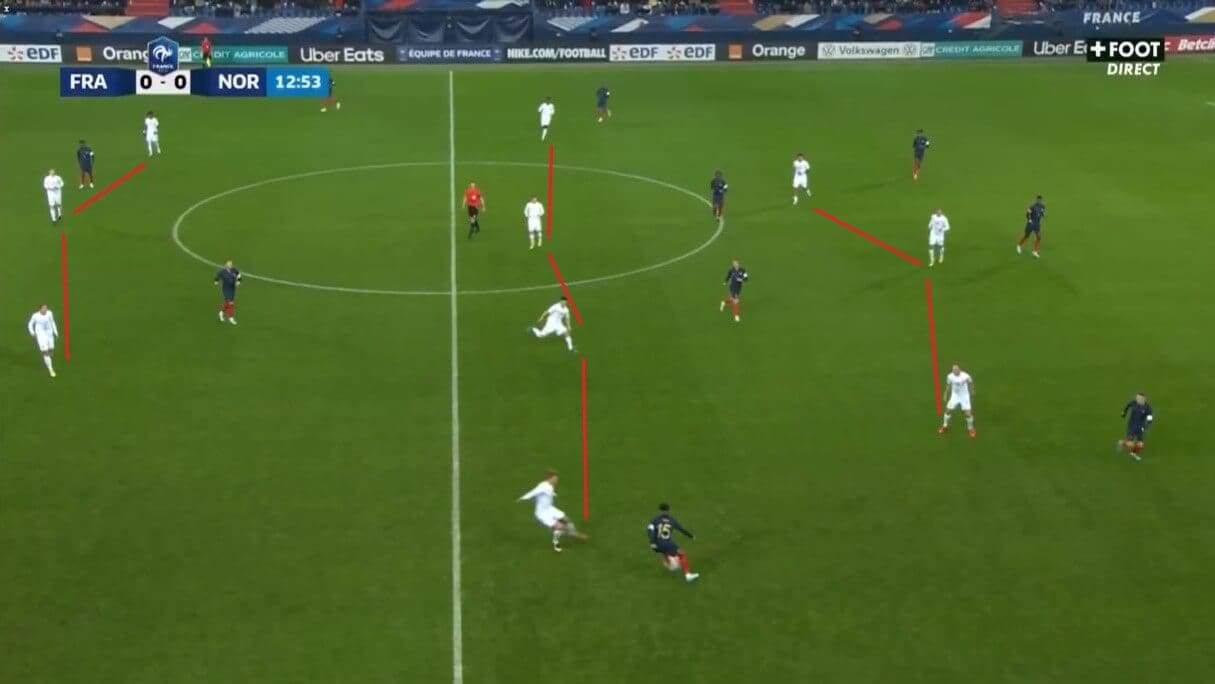
When they lose the ball, Norway, as mentioned, focus on trying to limit what their opponents can do, and that means getting into formation and each carrying out their roles.
It has already been mentioned that they are likely to start in a 4-4-2 formation, but their shape during games can change and adapt, depending on what is happening around them.
Against France, for example, Norway were being put under considerable pressure on the wings, with both Bayer Leverkusen’s Amine Adli and Crystal Palace’s Michael Olise cutting inside and getting into the half-spaces in order to play through the Norwegian ranks.
As a result, Norway felt that it would be more appropriate to set up in a 3-4-3 shape out of possession, with Evjen pushing forward to join the forward line and Sebulonsen switching to right wing-back to cover his absence, and that allowed them to then defend player-to-player and to prevent France from breaking them down as easily.
France did find a way to play through this setup by targeting the spaces behind the wing-backs, which is a weakness of this system, but the fact that Norway were able to adapt meant that they would be able to do so again if they spotted another issue that needed addressing, and that is something that could be worth keeping an eye out for during the upcoming tournament.
Norway Defenders
As mentioned, the full-backs are the players tasked with controlling the wings and ensuring that the team has constant width in attack, and, given what has already been highlighted, there is little doubt that Sebulonsen is the best player for the job on the right.
His crossing accuracy of 30.2% and the fact that he has been successful in 38.4% of his offensive duels may not stand out as much when compared to others around the pitch, but the fact that he can get forward and drop back at pace means that, tactically at least, he is someone that his side can rely on.
However, as mentioned when looking at the predicted starting XI, who will start at left-back is less certain, with both Oppegård and Hjelde being strong candidates.
In Oppegård’s favour is his offensive duels won, which stands at 65.7% compared to Hjelde’s 46.7%, and the fact that he averages more touches in the penalty area per game (1.17 compared to 0.49) makes him the better option for Norway when they are looking to win the ball high up the field and then get numbers into the opposing goal area.
However, if Norway changed their game plan and instead moved towards winning the ball and then delivering it into the middle, Hjelde would be the better player to have on the pitch, with his crossing accuracy of 77.8% more than double Oppegård’s 33.3%, so, again, they are different players and it really comes down to how Norway want to approach a match and what they are looking for in each game.
In the middle of the defensive line, there is little doubt that Daland, Heggheim and Rösler give Norway a blend of everything that they need.
However, given that they have established themselves as a strong partnership of late, it is likely to be Daland and Heggheim who are given the nod.
Yet, when it comes to their statistics, Heggheim is the better player in defensive and aerial duels, with him succeeding in 75% of his defensive duels compared to Daland’s 70% and 68.2% of his aerial duels compared to Daland’s 42.9%.
Therefore, when their backs are against the wall, Heggheim may well be the player that Norway look to when they need to win the ball and prevent their opponents from taking a shot on goal.
Where Rösler is strong is his ability to pass out from the back, with him registering a 95.2% passing accuracy across his two most recent U21 friendlies, and that will definitely appeal in games where Norway are perhaps enjoying a lot of possession and have the ability to play out from the back.
Norway Midfielders
In the central midfield areas, it is always about having the right balance, as has been made clear throughout the scout report — and with Hove’s passing accuracy of 81.5% making him the perfect fit for the deep-lying distributor role (Solbakken does have a higher accuracy of 91.7%, but has only played two games), it then becomes about who would be the right partner for him.
Christensen, as mentioned, is the player most likely to start, and his statistics are impressive, with him making 5.09 interceptions on average per game and winning 53.3% of his defensive duels, whilst also registering an 86.6% passing accuracy and winning 38.1% of his offensive duels.
Therefore, this again highlights how he can offer a lot in both defensive and offensive situations.
On the wings, Norway need players who can cut inside and support attacks centrally, and it has already been shown that Evjen fits that tactical profile.
His statistics are good in this regard, with him possessing a 73.5% dribble success rate and an average of 1.33 touches in the penalty area, so he is a good player to have available and it is little surprise that he is being picked out already as one to watch.
The fact that Evjen is such an attacking player is why Norway need balance on the other side of the field, and that is why Kitolano, whilst not an automatic starter, has been continually suggested as the best player to start on the left wing.
He has been successful in 57.1% of his defensive duels this season, compared to 36.4% of his offensive duels, so does offer the slightly more defensive characteristics that Norway will be looking for, but it really depends on what Smerud is looking for in each game.
Should he want to play with two attack-minded wide players and commit to an attacking philosophy, then someone who might come into the picture is Manchester City’s young prodigy Oscar Bobb, who is highly rated by many and seen as another star of the future.
Across two recent U21 friendlies, he registered a 57.1% dribble success rate and averaged 2.25 touches in the penalty area, meaning that he is not that different to Evjen.
However, he also has an 88.4% passing accuracy, compared to Evjen’s 84.8%, so he is marginally better at moving the ball around the pitch, and it would not be a surprise to see him come on in games where Norway need to play quicker football and look to not hold onto the ball for as long.
Norway Attackers
As mentioned at the beginning of this analysis, Norway rely on having a range of qualities in their forward line in order to allow them to both link up with those behind them and to pose a direct attacking threat at the same time, and this is why the combination of Botheim and Ceïde works so well for them, with Botheim dropping back and getting on the ball whilst Ceïde stays further up the field.
The statistics for both players from their various U21 outings (Ceïde’s four recent U21 friendlies and Botheim’s Euro U21 qualifying campaign) reflect that point, with Botheim posting a marginally better passing accuracy of 80.2%, compared to Ceïde’s 76.7%, whilst Ceïde has scored four goals and averaged 7.94 touches in the opposing penalty area, compared to Botheim’s three goals and 4.51 touches.
However, they are not the only players available to Smerud in the final third, and another who may well get some game time during the Euros is Reims’ on-loan Rosenborg player Noah Holm.
He has only played in two U21 friendlies of late, which is why he is more likely to be a substitute than a starter, but he matches Botheim’s goal number and wins more aerial duels than both him and Ceïde (Botheim has won 46.4%, Ceïde 42.9% and Holm exactly 50%), so he would be a bigger aerial presence should Norway opt to play more directly.
Norway Key Player
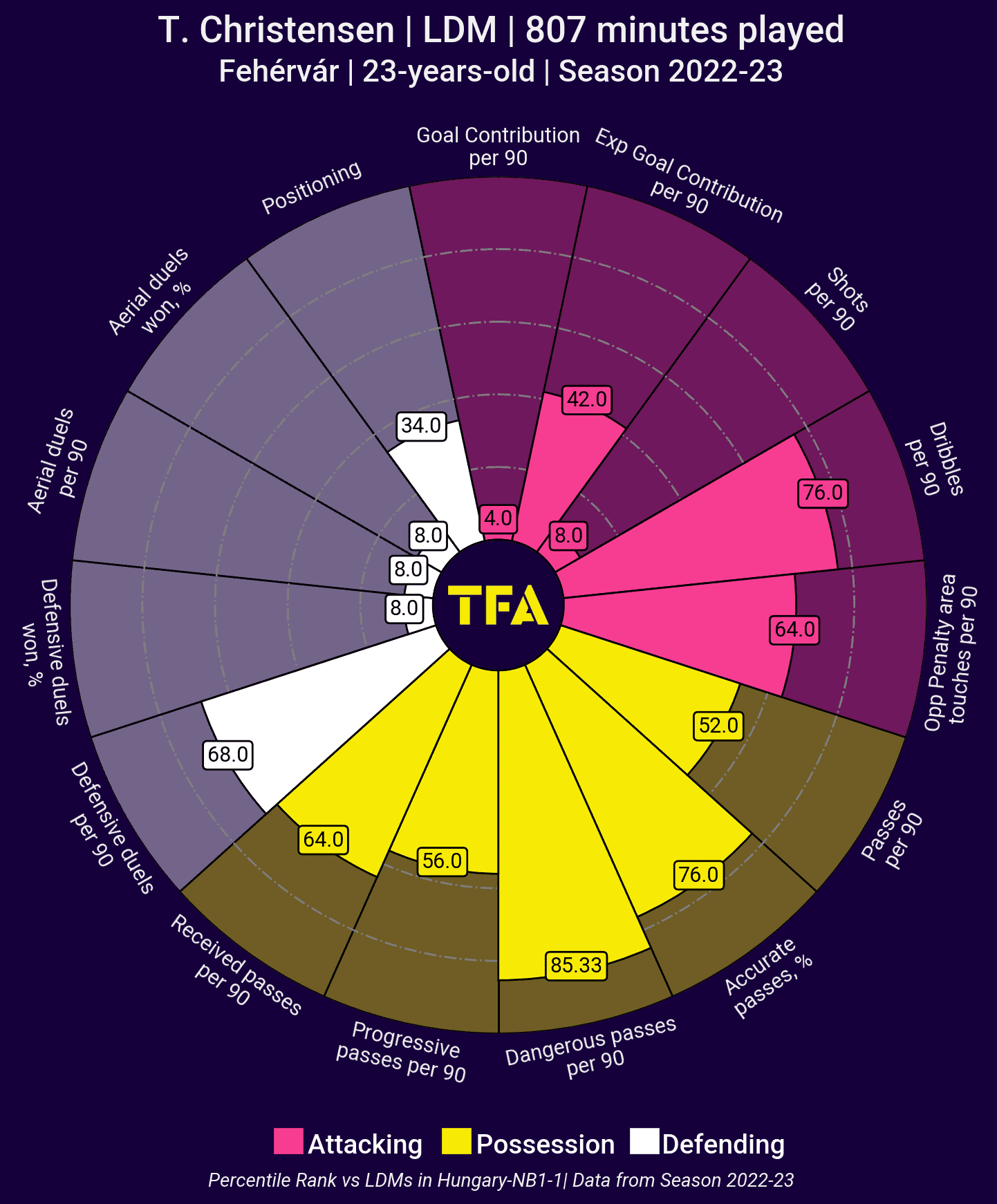
Many in the Norway squad have a chance of catching the eye during the Euro tournament, but the player that it looks increasingly like they cannot be without is Christensen, with not many others making the same attacking runs and defensive contributions simultaneously that he does.
It may be surprising to see in this graphic that he doesn’t actually contribute to that many goals, but this is likely down to him not being an attacking midfielder as such and therefore not often getting into areas where he can set up shots on goal.
Instead, he is the player who dribbles the ball forwards and provides the link during transitions, before then finding those ahead of him who are better suited to playing inside the final third.
However, this is not to put a downer on his overall attacking play, because it is also indicated that he is among the higher levels when compared to others in his position for both dangerous passes made and passing accuracy, so, again, he makes passes that create opportunities for his teammates from slightly further out but isn’t the one who makes the final pass or cross that leads to goals.
Defensively, he ranks highly for defensive duels engaged in per game, although he only wins just over half of them, and yet that is of no concern for fans as that role is not his when looking at the overall Norway midfield setup, and so it is not as if this aspect of his play not being as strong as others will let him and his nation down.
Tournament Prediction
Norway will face a tough ask to get out of their group at the Euros, with them facing three sides who will all put up a fight and who all have strong players in their squads, such as France’s Adli and Arnaud Kalimuendo, Italy’s Nicolò Rovella and Switzerland’s Noah Okafor.
However, they do still have a chance of making it out of the group, not only because they did so on both of their previous appearances at the tournament, but also because they have a clear style of play which the players believe in and which can produce results.
If they can maintain that and not lose confidence when things don’t go their way, then they will give themselves a strong chance of getting out of their group and into the knockout rounds.
It is not certain that they will get too far if they do finish top of their group though, so fans should prepare themselves for some element of disappointment in that regard.

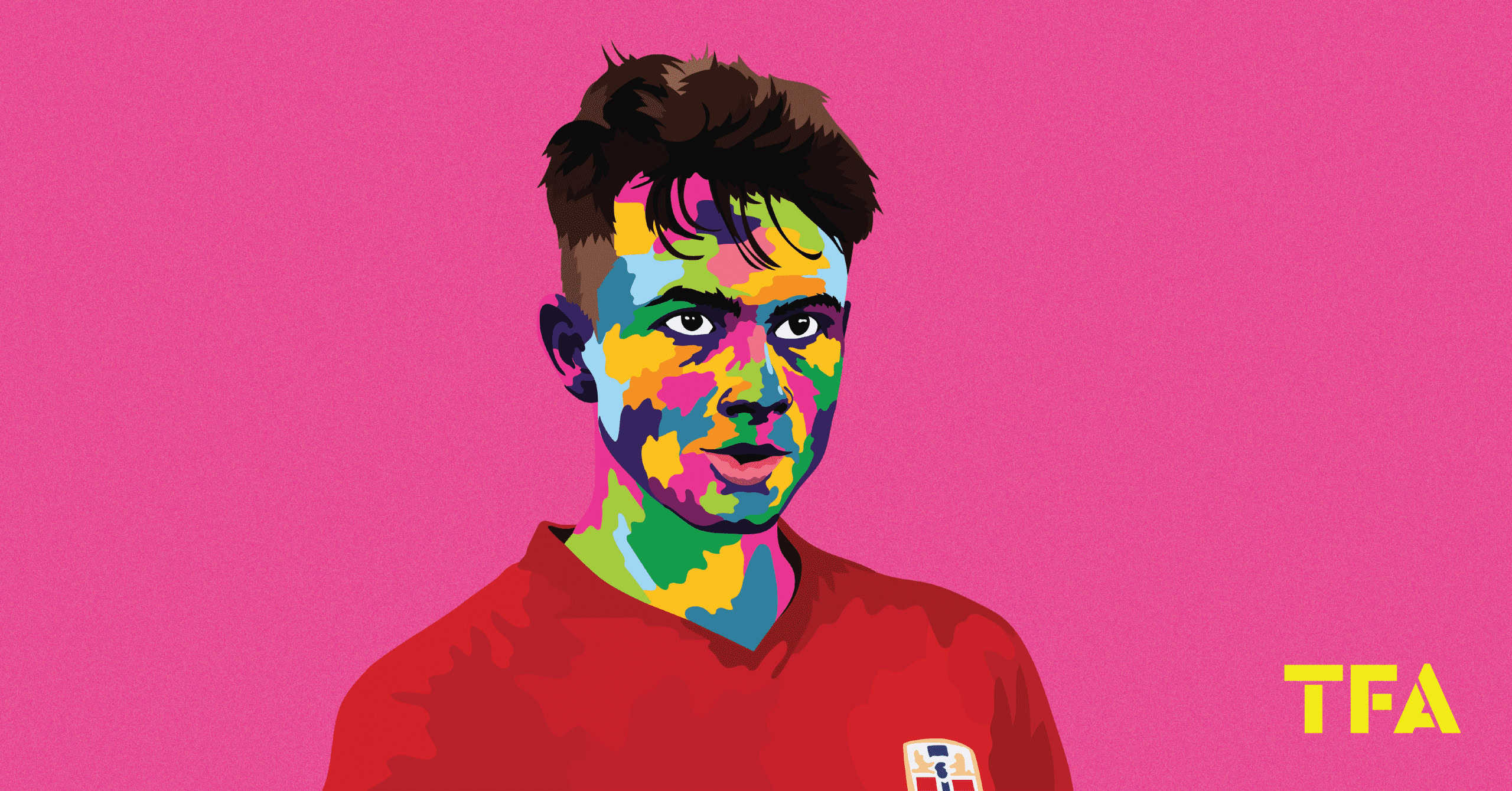



Comments